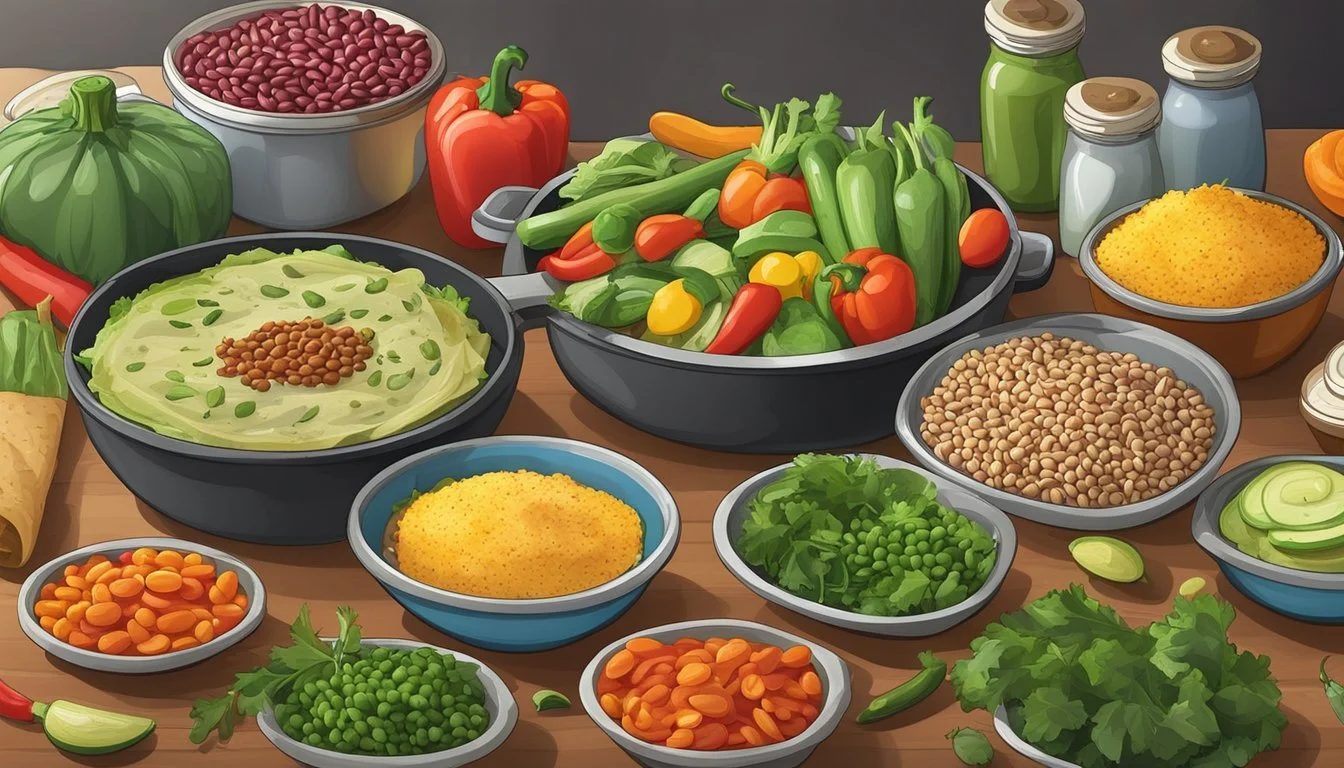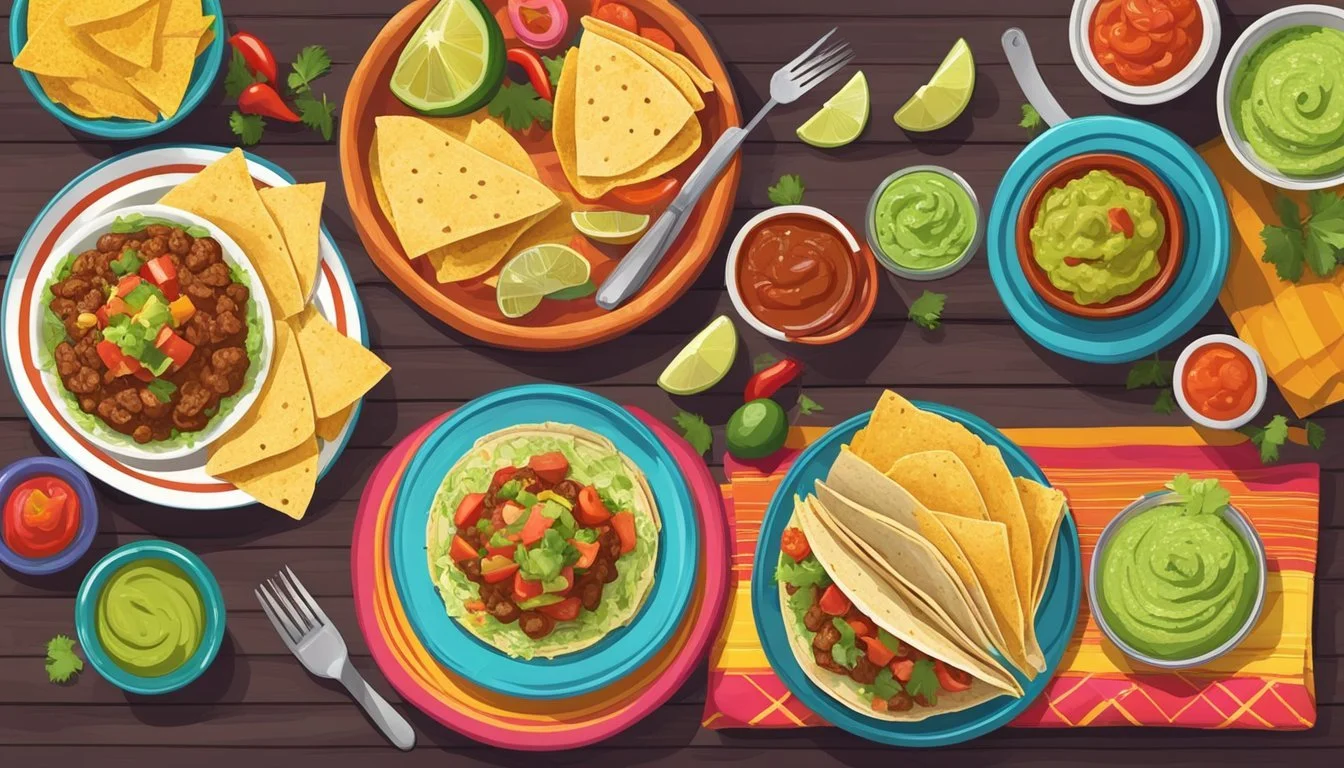How to Create a Tex-Mex Feast at Home
Your Ultimate Guide
Tex-Mex cuisine is a vibrant and flavorful fusion of Texas-style cooking with Mexican influences. It has become widely loved for its combination of spices, meats, and fresh ingredients, creating dishes that are both hearty and delicious. Crafting a Tex-Mex feast at home is a delightful way to immerse oneself in this culinary tradition, offering a bounty of options that can cater to a variety of tastes and preferences. Such a feast typically features an array of dishes from zesty appetizers (What wine goes well with appetizers?) to rich, satisfying mains.
To lay the groundwork for a genuine Tex-Mex spread, one might begin with a homemade salsa, made from the freshest ripe tomatoes, onions, cilantro (how long does cilantro last?), and peppers. This can be paired with classic Tex-Mex starters like an unforgettable guacamole, which gets its luxurious texture and depth of flavor from a base paste of onion, cilantro, chilies, and salt. Continuing the feast, mains could include succulent fish tacos, versatile Mexican shredded beef, and prawn tacos, each offering a unique take on traditional Tex-Mex staples.
Whether it's lime-marinated chicken ready for the grill or a comforting one-dish Tex-Mex beef with rice, the key to an authentic experience lies in the use of bold spices and fresh, high-quality ingredients. Preparing these elements with care and attention to detail will ensure that the resulting feast is not only visually appealing but also a true reflection of the rich cultural tapestry that is Tex-Mex cuisine.
Planning Your Tex-Mex Menu
Creating a Tex-Mex feast at home means curating a diverse and vibrant menu that combines savory mains, refreshing sides, starters packed with flavor, complementing beverages, and indulgent desserts. Each component should showcase the rich and hearty characteristics that define Tex-Mex cuisine.
Selecting Your Main Courses
For the heart of the meal, one should select a variety of main courses that cater to different tastes and preferences. Tacos and enchiladas are classic choices, with options to fill them with chicken, beef, or pork. The versatility of these dishes allows for a range of flavors, from the smokiness of chipotle to the freshness of lime-infused marinades.
Choosing the Perfect Sides
The sides should complement the main courses both in taste and texture. A balanced Tex-Mex menu features sides like Cilantro Lime Rice or a traditional bean dish. One might consider serving a Corn Maque Choux, a dish combining sweet corn with peppers and spices for a flavorful contrast to the rich mains.
Appetizers and Snacks
A Tex-Mex feast starts with a selection of appetizers to stimulate the appetite. Guacamole, salsa, and queso dip served with a bowl of crispy tortilla chips can create a communal and casual prelude to the main courses.
Beverages to Complement the Meal
The beverage selection should be refreshing and capable of cutting through the richness of the feast. A classic margarita, whether on the rocks or blended, is a crowd-pleaser. For non-alcoholic options, consider fresh agua fresca or sweet iced tea.
Desserts for a Sweet Finish
End the meal on a high note with desserts that carry a touch of Tex-Mex flair. Options include churros served with a side of chocolate sauce or a rich and creamy flan that provides a sweet contrast to the savory meal.
Shopping and Preparation
When planning a Tex-Mex feast at home, a shopper should prioritize fresh ingredients to ensure robust flavor in every dish. They should start by seeking out ripe tomatoes and a variety of peppers, including jalapeño or serrano for an authentic touch. For proteins, one should opt for fresh seafood for ceviche, quality beef for tacos, and chicken that can be marinated.
It's also vital to purchase fresh cilantro, limes, and avocados, central to dishes like guacamole, which begins with a base paste of onion, cilantro, peppers, and salt. Beans, rice, and cheese are foundational pantry items that require careful selection for the intended dishes.
Essential Ingredients
Tomatoes: Ripe for salsa.
Peppers: Jalapeño, Serrano for heat.
Proteins: Beef, Chicken, Fresh Seafood.
Herbs: Cilantro for freshness.
Citrus: Limes for zest and acidity.
Avocados: For creamy guacamole.
When they prepare ingredients, a cook might follow these steps:
Marinate: Prepare lime chicken marinade ahead of time to deepen the flavors.
Salsa & Guacamole: Dice ingredients and combine just before serving to maintain freshness.
Rice Dishes: Pre-cook rice to a bit under tenderness as it will continue to cook in a baked casserole.
Additionally, one should employ sturdy cookware such as clay vessels, which not only cook evenly but also contribute to the distinct flavor profile renowned in Tex-Mex cuisine.
To achieve homemade authenticity, it is crucial for a person not to rely on pre-made mixes and to invest time in preparing pastes and mixes from scratch. This does not only elevate the taste but ensures a genuine Tex-Mex experience.
Cooking Techniques and Tips
Creating a Tex-Mex feast at home involves mastering a blend of simple yet specific techniques that are key to authentic flavors. Each step, from preparing the staples to the presentation, contributes to an enjoyable dining experience.
Mastering Tex-Mex Staples
To lay a strong foundation for your feast, one must know how to prepare the basics. Tortillas should be soft and warm, achieved by briefly heating them on a skillet. Beans and rice serve as staple sides, with beans often simmered with aromatics, and rice toasted before boiling to enhance its flavor.
Recipes with rice: Toast in a skillet with a bit of oil until golden, then simmer with a blend of tomato sauce, garlic, and onions.
Beans: Pinto or black beans can be cooked slowly with cumin, garlic, and chiles for rich flavor.
Utilizing Kitchen Equipment
Tex-Mex cuisine can benefit greatly from both stovetop and slow cooking methods. A slow cooker is ideal for creating tender pork carnitas (What wine goes well with pork carnitas?) or flavorful beef that shreds easily. Meanwhile, a skillet is perfect for quick-cooking items like fajitas.
Slow cooker: Set to low cook mode for several hours with spices and seasonings for tender meat.
Skillet: Utilize high heat for searing meats or sautéing vegetables to create a charred, smoky flavor.
Perfecting Meat Preparation
When preparing meat such as beef, chicken, or pork, marinating is key. Create a marinade with lime juice, cumin, coriander, chili powder, kosher salt, and black pepper. Marinate for several hours to ensure the flavors fully penetrate the meat.
Beef: Marinate skirt or flank steak for fajitas with the above spices and cook on high heat to sear.
Chicken: Marinate chicken thighs (What wine goes well with chicken thighs?), which retain moisture better and impart deep flavors when grilled or roasted.
Achieving the Right Flavor Balance
Tex-Mex cuisine is characterized by its robust and vibrant flavors. Balance is key, incorporating earthy cumin, hot chiles, aromatic coriander, and tangy lime. Utilize a mix of fresh and dried spices to layer flavors.
Spices: A combination of cumin, coriander, and chili powder typically creates the backbone of Tex-Mex seasoning.
Fresh components: Fresh garlic, jalapeño, and cilantro add brightness to dishes like salsa or toppings.
Assembling and Garnishing
Proper assembly enhances both the taste and visual appeal of Tex-Mex dishes. Layer ingredients thoughtfully and finish with a selection of toppings like sour cream, cheese, and jalapeño. Freshly chopped cilantro and a squeeze of lime add a final touch of flavor and color.
Layers: Begin with a base of rice or beans, add your main protein, and then pile on the toppings.
Garnishes: A dollop of sour cream, a sprinkle of cheese, and a scattering of cilantro should be applied just before serving.
Serving and Presentation
Presentation is an integral part of the Tex-Mex experience. Serve food in a way that showcases its variety and vibrancy. Use colorful dishes and arrange the feast family-style, encouraging shared dining and interaction.
Dishes: Choose plates and bowls that make the colors of the Tex-Mex cuisine pop.
Family-style: Large platters allow for guests to build their own plates and enjoy a communal dining experience.
Creating Authentic Tex-Mex Atmosphere
To truly transport guests to the heart of a Tex-Mex fiesta, attention to detail in atmosphere and decoration is paramount. A well-considered combination of vibrant colors, appropriate music, and engaging activities is key to giving your gathering the zest of a Mexican fiesta with a Texan twist.
Setting the Table with Mexican Flair
For the table setting, bold colors like red, green, and yellow evoke the warmth of Tex-Mex culture. Consider using:
Tablecloths or placemats in these colors or with traditional Mexican patterns.
Earthenware plates on top of woven-fiber place mats to lend an authentic touch.
Serveware such as terracotta or brightly colored ceramic dishes.
Centerpieces can feature miniature cacti, bright flowers, or hand-painted maracas to pull the look together.
Theming Your Feast
The fusion of Texan and Mexican culinary traditions means your decor can play with both cultures. Hang banners or papel picado (hand-cut paper decorations) to create a fiesta ambiance. For a Texan touch, add elements like:
Bandana-patterned napkins or table runners.
Small horseshoes and cowboy hats as table décor.
Music and Entertainment
Music sets the mood; a playlist with a mix of Tejano, Mariachi, and contemporary Latin beats will keep the atmosphere upbeat. If space allows, hiring a live band could be an unforgettable highlight.
For entertainment, consider:
A dance area where guests can try salsa or line dancing.
Classic Mexican film screenings in a low-volume setting for ambiance.
Engaging Guest Activities
Interactive activities can elevate your gathering:
Allow guests to mix and match fillings and toppings to make their own tacos.
Games: Traditional Mexican games like Lotería (bingo) or piñata for kids and the young at heart.
These activities not only amuse guests but also immerse them in the Tex-Mex experience by having them partake in traditions.
Post-Feast Tips
After the enjoyment of a Tex-Mex feast, it's essential to handle leftovers safely, clean up effectively, and share your experience with others.
Handling Leftovers
Any remaining food should be dealt with promptly to prevent spoilage. Here's how one can manage leftovers:
Refrigerate promptly: Leftovers should be stored in the refrigerator within two hours of serving to keep them safe for consumption.
Proper containers: Use airtight containers to preserve the freshness of the food.
Label and date: Clearly label each container with the content and the date it was stored. This will help keep track of how long leftovers can be safely consumed.
Creative reuse: Consider repurposing leftovers into new meals, like transforming beef and rice into burritos or using salsa as a flavor booster for omelets.
Clean-Up Strategies
Efficiency in cleanup is key to wrapping up a successful feast. They can follow these strategies:
Soak dishes: Soaking pots, pans, and serving dishes makes them easier to clean later.
Recycle and compost: Separate recyclables and compostable food scraps from regular waste to reduce environmental impact.
Systematic approach: Clean from the cleanest item to the dirtiest and from the top of the kitchen to the bottom to avoid recontamination.
Sanitize surfaces: After the dishes are done, wipe down counters, stovetops, and tables with a sanitizing solution.
Sharing Your Experience
Sharing one's culinary triumph can inspire others and document the experience:
Social media sharing: Use platforms like Instagram to showcase pictures of the feast. One should use relevant hashtags, such as #TexMexFeast, to reach like-minded food enthusiasts.
Write a recap: A blog post or social media write-up detailing the event, recipes used, and any tips for others interested in hosting a similar feast can be valuable.
Feedback solicitation: Ask guests for their honest feedback on the dishes to improve future feasts. This can be done casually at the end of the event or through follow-up messages.




